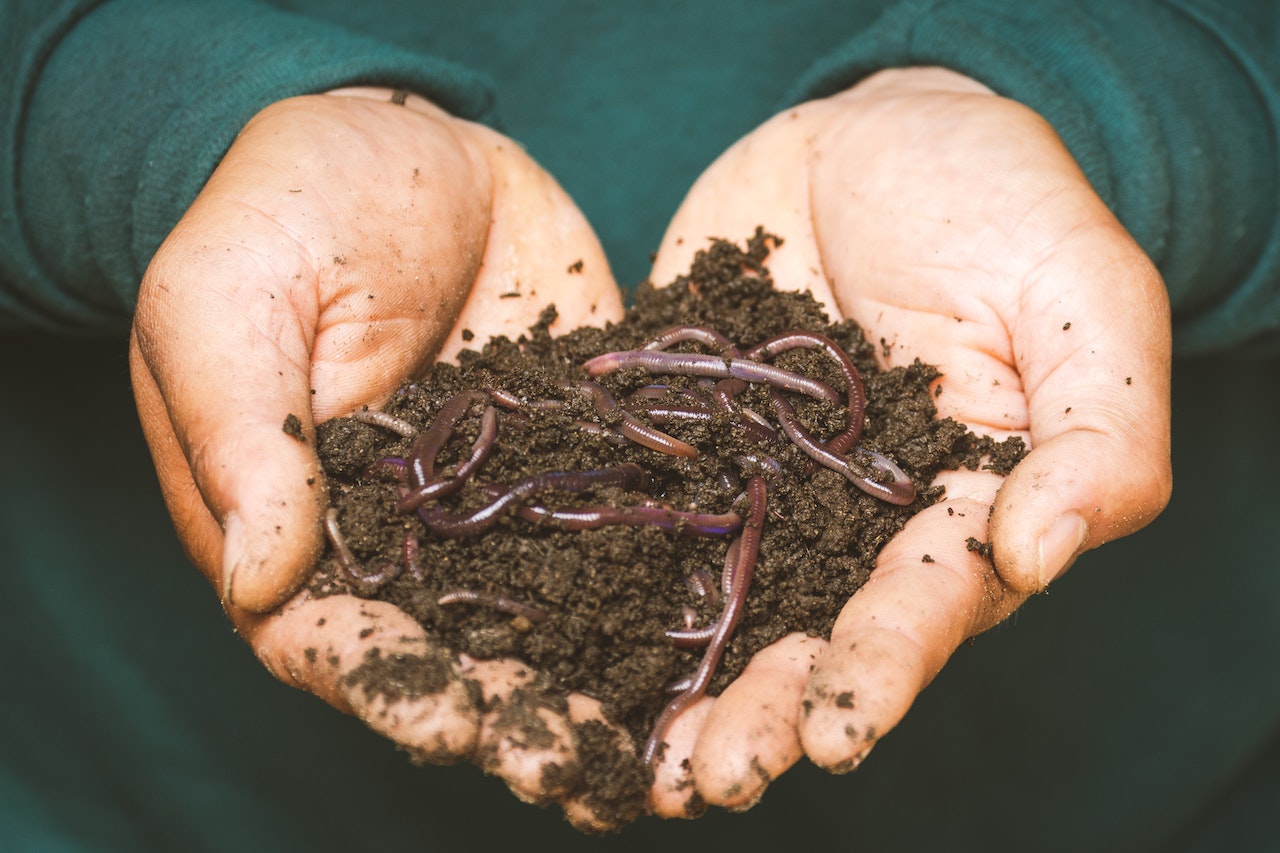The best worms for composting are epigeic worms (such as red wigglers, redworms, brandling worms, and African nightcrawlers) because they inhabit the soil’s surface where the composting process happens.
Table of Contents
5 Best Worms for Composting
1. The Red Wiggler Worm
The red wiggler worm (Eisenia fetida) is an earthworm mostly used for vermicomposting because it’s easily purchased. It’s also one of the most common worms sold as pets.
These worms are small and less muscular and can grow up to 5 inches long and ¼ inches wide. They are reddish-brown, with a yellowish tail, and have a pointed head.
The red wiggler is an epigeic worm that can consume up to half its body weight daily. They can feed on any kitchen and food waste, quickly breaking down decomposing organic matter into high-quality compost.
What’s more, wiggler worms are a better option for vermicomposters because they reproduce rapidly, especially in warm climates (55°-95°Fahreineit).
A high population of worms means more organic material is decomposed.
2. European Nightcrawlers
European nightcrawler (Eisenia hortensis) is often considered close relatives to red wigglers because they reproduce quickly.
They’re also easy-to-raise farm worms because they’ll only need moisture, food, suitable pH, and worm bedding.
A fully grown nightcrawler is about 4 inches long and can weigh up to 1.5 grams making it larger than a red wiggler. For this reason, it’s also sold as fishing bait.
Generally, the nightcrawler’s body is branded, blueish or pink-grey, and has a pale yellow tail.
And unlike the red wigglers who thrive in warm temperatures, European nightcrawlers prefer cooler climates.
3. African Nightcrawler
Also known as Eudrilus eugeniae, African nightcrawlers are good composting tropical worms well suited for places with high temperatures (with enough moisture).
These worms might be perfect for you if you’re a farmer from hot regions such as Hawaii, Louisiana, Texas, and Florida.
Vermiculture experts suggest that your soil should be at least between 75-85ºFahrenheit when dealing with these worms because they might start dying when the temperatures drop, even if it’s up to 60º Fahrenheit.
African nightcrawlers are 4-8 inches long and are purple grey.
These worms consume a lot of compostable materials in a day and therefore may require you to feed them more often.
However, they’re not good burrowers meaning they don’t do well in dense garden soil.
4. Indian or Malaysian Blue Worms
The Malaysian blue worms (Perionyx excavatus) are suitable for tropical climates. It’s an epigeic worm that processes organic materials on the soil’s surface.
In terms of size, the blue worms are smaller than the red wrigglers and can grow up to 3 to 4 inches.
They have a banding pattern and lack a raised Clitellum.
5. The Alabama or Georgia Jumper
Alabama or Georgia jumper worms, also known as Amynthas gracilis, are worms that thrive in tropical and subtropical regions. Apart from vermicomposting, they are often used as bait for fishing and are edible.
The name “jumper” is because these worms can jump several inches out of the ground when alarmed.
Alabama jumpers are common in North America and Asia.
What Type of Bedding Is Best for Worms?
Once you identify the right type of worms for your vermicomposting bin, you must set up the right bedding for them.
The following are suitable bedding materials you can use:
- Leaves
- Shredded paper
- Egg cartons
- Shredded cardboard
- Straw
It’s best to leave out the leaves and straw when composting indoors because these materials attract insects and other bugs.
Once your worm bed is ready, add garden soil and pour in water because worms thrive in moist conditions.
The moisture content of your bedding should be similar to a wet sponge for the best worm habitat.
You can always add dry material to the bedding if you poured too much water into your vermicompost.
How Many Worms Should You Get for Composting?
You need about one pound of worms per square foot of your vermicomposting bin. You can also measure it as one pound of worms per pound of food waste.
Keep in mind that there are about a thousand mature worms in a pound. Still, it would help if you considered other factors when calculating the number of red wigglers for your worm farm.
Can You Have Too Many Worms in Your Compost Pile?
Yes, it’s possible to have too many worms in a vermicomposter.
Still, some types of worms, like red worms, can regulate their population to suit their environment in case of food shortage or limited space.
These worm species can slow their reproduction rate to maintain a good population level or increase the death rate of adults to pave the way for the young ones.
Ensure you get the correct number of worms that fit the available food waste to avoid overfeeding or starving them.
If you notice an overpopulation in your worm composting bin, you can always transfer some of them to a separate worm bedding in a different compost pile.
Can You Use Regular Earthworms for Composting?
No, regular earthworms are unsuitable for composting.
The primary difference between earthworms and compost worms is that earthworms are burrowers while the latter are composters.
While both types of worms improve soil quality by decomposing organic waste, earthworms are mainly helpful for improving aeration and drainage in garden soil.
Also, you can only find earthworms at the bottom of the bin because they don’t work on the surface, requiring you to turn your compost constantly.
Buying the Right Worm for Your Compost
It’s difficult to distinguish between some red worms and earthworms, so the best option is to order them online or buy from a local supplier.
Red wigglers were previously only available as bait at fishing shops, but after their popularity increased, they became a common product for many companies to sell.
Today, you can buy these worms from online garden stores and have them shipped straight to your doorstep.

